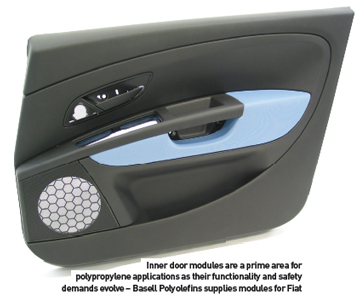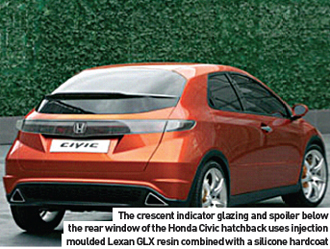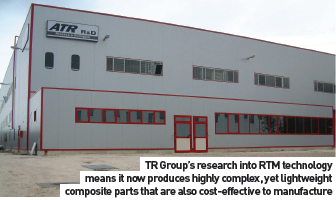A range of innovative and versatile plastic-moulded components are being eagerly adopted by the automotive industry as it strives to save weight and stay cost effective
One of the stated aims of US legislators is to raise the fuel economy of cars and light trucks to 35 mpg. That will not be a simple task but there is a batch of off-the-shelf technologies that can bring automakers close to the goal, including the increased use of plastic.
Today’s plastics have revolutionised the design of auto body exteriors. From bumpers to door panels, lightweight plastic gives cars better petrol consumption, and allows designers and engineers the freedom to create innovative concepts that wouldn’t be possible otherwise. Traditionally, metal alloys were synonymous with auto body exterior design and manufacturing. However, metal alloys are susceptible to dents, stone chips and corrosion. They are also heavier and more expensive than plastic. Choosing plastics for auto body exterior parts allows manufacturers to adopt modular assembly practices, lower production costs, improve energy management, achieve better dent resistance, and use advanced styling techniques for sleeker, more aerodynamic exteriors.
Automobile design engineers face many constrictions when designing with metal. Low-cost, single-unit production of large automobile sections, such as a front grille, is nearly impossible when using metal. Plastic offers auto engineers a variety of practical, cost-effective alternatives, as well as tremendous advantages over traditional automobile production materials.
 New processes enable manufacturers to reuse scrap plastic and recycle used plastic cost-effectively. Also, plastic components weigh approximately 50 per cent less than their steel counterparts. This enables automobile components to be substantially lighter while retaining strength and contributes to an overall lighter vehicle and, therefore, fewer emissions and improved gas mileage.
New processes enable manufacturers to reuse scrap plastic and recycle used plastic cost-effectively. Also, plastic components weigh approximately 50 per cent less than their steel counterparts. This enables automobile components to be substantially lighter while retaining strength and contributes to an overall lighter vehicle and, therefore, fewer emissions and improved gas mileage.
One material that is making increased in-roads in automotive manufacturing is the versatile polymer polypropylene. It serves a double duty, both as a plastic and a fibre. Among its many characteristics is its high tolerance of heat; it was traditionally used to make things like dishwasher-safe food containers, as it does not melt below 160oC (320oF).
Steve Dwyer, Basell’s Senior Vice President, stresses the importance of polypropylene as the industry’s most cost effective polymer for automotive engineers. He notes that, depending upon the car segment, up to 60kg of the material is used per vehicle and, of that, compounded polypropylene and reactor TPO materials represent about 45kg per car.
This is a testimonial to the versatility of the material and its cost effectiveness, and this volume could even reach 55kg per car.
“Even with existing applications however there are opportunities,” he says. “Bumper fascias can be integrated with car body surfaces, reducing weight and eliminating another component. In the interior an example would be the further use of polypropylene-based products to replace engineering materials in instrument panel applications, an area not fully exploited yet.
New interior air bag systems are also providing opportunities for the use of reactor TPO products.
“Another key area is body panels. With new high stiffness, lower thermal expansion polypropylene materials, it is possible to replace PPO/PA or PC/PBT alloys. In particular, for tailgates both the outer and inner panels can be made from polypropylene-based products.
“On the roof new polypropylene-based products can be used to replace ASA polymers in roof rail applications.
Inner door modules are another good opportunity as their functionality and side impact requirements continue to evolve. Short glass reinforced PP materials can be used to reduce component weight and cost. With the improvements in short glass PP-based products, it is also possible to consider their use in front-end modules.
In a time where many automotive OEMs and their key suppliers face challenging times Dwyer says: “I see a lot of opportunity – especially for the use of polypropylene-based materials to help solve some of the industry’s challenges.”
A hollow glass microsphere capable of withstanding injection moulding and extrusion pressures of 30,000 psi, and making high-volume production of lighter and cheaper interior automotive components possible, has recently been introduced by 3M.
It is being offered as an alternative to conventional additives/fillers such as glass fibre, calcium carbonate and talc. This next generation in glass microsphere technology, combines lightweight with the high strength needed to survive rigorous compounding and injection moulding pressures. The new additives are 40 per cent stronger than previous leading high strength glass microspheres and, at 18 microns, are approximately half their size.
This added resilience means iM30K additives can be easily incorporated into the moulding and forming processes that are common in the automotive industry. A Tier One supplier has already demonstrated the benefits that it could offer.
Hyundai Mobis, the parts and service arm for Hyundai and Kia, conducted a 19-month long series of tests comparing PC/ABS with a new polypropylene material filled with 3M iM30K additives for use in moulding automotive instrument panel core parts. According to Mr S Ka, Research Engineer for the Cockpit Module Design project, the use of the additives has demonstrated a number of important advantages. “We were exploring new material formulations that would help reduce overall part weight and costs in the production of instrument panel core parts,” explains Ka. “Using the polypropylene material that contained the additives we achieved a 16.8 per cent weight reduction and the finished part cost was 50 per cent lower than PC/ABS IP cores. In addition, we experienced improved material flowability than PC/ABS and better dimensional stability compared to current talc filled polypropylene.”
With the growth in the use of thermoplastics in vehicles, driven by higher fuel costs, the demand for lighter weight plastics parts continue to increase. At the same time, moulders and compounders alike are seeking ways to reduce energy usage and cycle times, while improving product quality. “We continues to tap its technology base to respond to these ever-changing needs,” says Lou Lundberg, Business Manager, 3M Specialty Materials Division. “Our iM30K additives are the newest addition to the company’s portfolio of glass microsphere offerings to meet these demands.”

When DaimlerChrysler unveiled the latest iteration of its Viper to the assembled media at the Detroit motor show earlier this year the focus was on its performance, but unbeknown to them some of that power gain had been achieved thanks to innovative use of plastics.
By taking advantage of the sheet-moulded plastic compound used for the hood, designers of the 2008 Viper SRT10 were able to create a more aerodynamic flow and better engine performance. “We need to stay light and cost-effective,” Herb Helbig, Design Powertrain Engineer for the Chrysler group team, said at the time.
The new Viper retains the plastic body panels of past sports cars and continues the use of carbon fibre for structural parts, including the front fender supports.
But it is the bonnet, moulded by Meridian Automotive Systems, which provides the most dramatic difference. Chrysler designed a 4-inch rise at the centre and openings along each side to help circulate the air better within the engine compartment.
They are not the only US manufacturer to make use of plastics for body panels. Michigan companies Meridian, of Allen Park, and Continental Structural Plastics, of Troy, are turning out composite boxes for thousands of trucks sold annually by both US and Japanese automakers.
General Motors, which is eliminating thermoplastic body panels from its Saturn cars, is using GE Plastics’ Noryl GTX resin for fenders on the Hummer.
When Mitsubishi Motors Corporation began designing the fifth-generation Delica minivan, dubbed the D:5, a key goal was to reduce the weight of the vehicle for improved fuel efficiency. Mitsubishi decided to replace traditional steel with plastic in the front fenders of the Delica, but had a long list of requirements for this new material. The automaker wanted a resin that would provide design flexibility to consolidate a number of parts into the fender component, and enable on-line painting to reduce overall system costs. Above all; however, the plastic fenders had to look great and provide excellent impact resistance.
The 2007 Mitsubishi Delica D:5 minivan is the fifth generation in a line of multi-purpose vehicles. However, MMC had consumer excitement in mind with the design of the latest version that is targeted at the Japanese market.
The company wanted a vehicle that would exceed customer expectations with eye-catching style, excellent fuel efficiency, exceptional handling, and enhanced passenger safety. At the same time, it wanted to reduce overall system costs through part consolidation and streamlined processing, while supporting its environmental protection efforts.
The automaker decided that a metal replacement strategy for the front fenders would help achieve all these objectives by reducing weight and providing greater design freedom.
The hard part would be finding just the right plastic to deliver on all the other requirements: weatherability, chemical resistance, conductivity for electrostatic painting to reduce volatile organic compound (VOC) emissions, excellent surface flatness and gloss, and high process ability for shorter cycle times.
“Our vision for this new generation design was to revolutionize consumers’ existing ideas about the Delica,” Hidenori Uki, manager of product at Mitsubishi Motors Corporation says. “Today’s car buyer is sophisticated, with a host of expectations. Therefore, this metal-replacement project had to contribute design, aesthetic, and weightreduction benefits without sacrificing any of steel’s performance characteristics.”
Mitsubishi chose to work with GE Plastics due to the supplier’s extensive experience in plastic body panel design and processing, and its comprehensive technology support capability. Mitsubishi ultimately selected GE’s Noryl GTX 979 resin, a blend of polyamide (PA) for stiffness and heat resistance for on-line painting, and modified polyphenylene oxide (PPO) for weatherability and impact resistance.
The low density of unfilled Noryl GTX resin can provide significant part-weight savings. And the material can deliver a Class A surface finish to provide excellent aesthetics.
The fenders, which integrate previously separate parts including the door line shield, body assembly brackets, and “snap-on” brackets for the bumper, are injection moulded and on-line painted. Noryl GTX resin is inherently conductive, making it ideal for electrostatic painting that can minimize emission of harmful volatiles.
The use of this material enabled Mitsubishi to lower the weight of the Delica’s front fenders by four kilograms compared to steel, contributing to improved mileage and greater manoeuvrability. At the same time, the high impact resistance enables the Delica’s fenders to resist dents.
From a manufacturing standpoint, Mitsubishi has achieved multiple benefits including high processability for faster cycle times. “We’ve designed a new Delica van that fulfils consumers’ desire for high style and an enjoyable driving experience combined with down-to-earth practicality,” Uki explains.
It is not just high-volume cars that can benefit from innovative plastics technology, as evidenced by Huntsman’s work on the stunning Ferrari F430. An advanced Resin Transfer Moulding system (Advanced RTM) developed by the ATR Group and Huntsman Advanced Materials has been used on a prototype engine air box for the car.
The ATR Group is an Italian consortium comprising nine leading companies involved in the research and production of advanced structural composite parts and components. Using ATR’s RTM technology and a new epoxy resin system from Huntsman – it was possible to build the highly complex prototype of the engine air box. The process was so revolutionary it won the highly prestigious 2006 China Composites Expo-JEC Innovation Award for the best application for FRP/Composites Production in September 2006.
RTM is an established moulding process in which a catalysed resin is transferred into an enclosed mould, lined with reinforced fibrous material. It then may or may not be heated to complete the moulding process. The main benefit of RTM is that it combines relatively low cost tooling and equipment costs with the ability to consolidate large structural parts.
The system is innovative because it enables the production of detailed composite parts in a single shot. It also reduces the weight of the part by minimising the amount of resin used.
With the Ferrari F430 engine air box, the weight of the finished prototype part was virtually halved from the aluminium original – down from 4.1kg to just 2.4kg. This was achieved by using a special, flexible silicone membrane rather than the usual metal RTM mould, which enabled the resin content to be reduced and the reinforced fibre content to be increased. Additional external pressure was also applied to the membrane to optimise this process.
Although highly complex, the prototype part produced using this advanced RTM system was extremely accurate – even the engine flange drill holes matched up with no further finishing required.
No additional bonding was needed either to add connecting parts such as inserts and internal auxiliary structures as they were formed in the mould during the RTM process.
Abramo Levato, R&D Manager at ATR Group says: “With our significant advancement in RTM technology it is possible to produce highly complex, yet lightweight composite parts in a single shot. This versatile laminating system makes Advanced RTM an even more time and cost-effective manufacturing option for our customers.”
The Honda Civic is one of the world’s most popular cars, due to its combination of style and practicality.
In designing the hatchback model the Japanese manufacturer wanted to incorporate an aggressive new styling element termed an ‘extra window’. This curved piece of glazing is placed below the rear window and incorporates both a spoiler and brake-light indicator. A large, complex part, the extra window presented design and manufacturing challenges that ruled out traditional glass and even some plastics. To achieve the required part integration as well as superior performance and weatherability while ensuring good rear visibility for the driver, Honda’s Tier One supplier, Freeglass, chose to work with GE Plastics.
In creating the new Honda Civic hatchback, Honda sought a fresh design that would add aggressive, edgy styling while continuing the Civic’s tradition of practicality. This crescent-shaped part, located just below the rear window, would integrate a spoiler for improved aerodynamics, as well as the brake light indicator for part consolidation.
However, the extra window design presented a number of challenges, ranging from the large size and complexity of the component to the need for adequate driver visibility without distortion. Several material solutions were investigated and glass was quickly ruled out, because it could not accommodate the sharp curvature of the part. Glass also had the drawback of heavier weight compared to plastic.
So Honda and Tier One supplier, Freeglass focused on plastic glazing. Dr Gerald Aengenheyster, Managing Director of Freeglass explains: “We consulted GE Plastics about the best solution for the extra window.
By combining Lexan polycarbonate resin with a special silicone hard coating, GE was able to meet all our requirements.”
GE Plastics proposed transparent, injection moulded Lexan GLX resin combined with a silicone hardcoat for the extra window application. Lexan GLX resin provides high impact strength, stiffness, and weight saving that are especially valuable in automotive glazing applications. For protection against abrasion and degradation from UV light and chemicals, the resin is coated with a silicone based hardcoat.
The solution not only enabled Freeglass to successfully produce the extra window, but it helped Honda and Freeglass win an award from the Society of Plastic Engineers (SPE) Europe. The part won third place in the Body Exteriors category for 2006.
 The design flexibility of Lexan GLX PC vs glass made it possible to create the dramatic 3D crescent-shaped part and to seamlessly integrate the spoiler and the brakelight mount. The combined glazing element provides eye-catching styling as well as sleek aerodynamics for the hatchback.
The design flexibility of Lexan GLX PC vs glass made it possible to create the dramatic 3D crescent-shaped part and to seamlessly integrate the spoiler and the brakelight mount. The combined glazing element provides eye-catching styling as well as sleek aerodynamics for the hatchback.
“Thanks to the extra window, the Civic’s overall design is fresher and more exciting - and it has proved very attractive to customers,” said Stuart Cock, Senior Project Engineer. “This model has been selling extremely well.”
From a performance standpoint, the resin provides better impact resistance and stiffness than PMMA. The durable hardcoat protects the window from abrasion due to road debris and chemicals such as salt, as well as UV degradation. In fact, this hardcoat provided four times better performance than competing products in accelerated weathering tests.
The crystal clarity of Lexan resin provides optimal visibility for the driver, helping to increase safety.
Furthermore, using PC allows a larger area of visibility compared to existing glass use. This could result in increased safety for the driver as issues related to classical design of such cars is that visibility to the rear is limited, which sometimes generates criticism in car testing. “The aesthetics, performance, and style of the extra window have been recognised by the auto industry and, more importantly, by our customers,” Cock says.



































